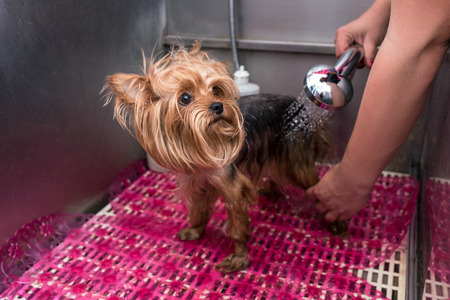Understanding Your Dog’s Bathing Needs
Bathing your dog is an essential part of pet care, but the ideal frequency depends on several factors unique to each dog and their living environment in the UK. The British climate, with its frequent rain and variable temperatures, means that dogs often encounter mud, wet grass, and urban pollution during their walks. This makes it vital for UK pet owners to tailor their dog’s bathing schedule to suit their pet’s breed, age, and lifestyle.
Breed Differences: Some breeds have oily coats that naturally repel dirt and require less frequent washing, while others—especially those with long or thick fur—may need more regular baths to prevent matting and odour. For example, a Labrador Retriever may need a bath every couple of months, whereas a Cocker Spaniel might benefit from monthly grooming.
Age Considerations: Puppies generally have more sensitive skin than adult dogs and should be bathed only when necessary using gentle, puppy-specific shampoos. Senior dogs may also have delicate skin or underlying health conditions affecting how often they can be bathed.
Lifestyle Factors: Dogs who enjoy countryside rambles or regular trips to the park are more likely to get muddy and may require more frequent cleaning compared to pets who spend most of their time indoors.
Recommended Bathing Frequency for UK Dogs
| Dog Type | Suggested Bathing Frequency | Considerations |
|---|---|---|
| Short-haired Breeds | Every 2-3 months | Less prone to matting; check for skin irritation post-walks |
| Long-haired Breeds | Every 4-6 weeks | Brush regularly; increase frequency if exposed to mud frequently |
| Puppies | As needed (infrequent) | Use mild shampoo; keep baths short and warm |
| Seniors/Medical Needs | As advised by vet | Monitor for dryness or skin issues; use prescribed products if necessary |
| Active/Outdoor Dogs | Monthly or after heavy soiling | Rinse paws after walks in muddy areas; avoid overwashing to protect natural oils |
The Impact of the British Climate & Environment
The UK’s damp weather can make keeping your dog clean a challenge. Muddy puddles, wet leaves, and city grime are common culprits for dirty coats. However, overbathing can strip away natural oils essential for healthy skin and fur. Always consider local environmental factors such as urban pollution or rural allergens when determining bathing routines. By adapting your approach to your dog’s individual needs and the unique British environment, you’ll help maintain their comfort, health, and happiness throughout the year.
2. Choosing the Right Products and Equipment
Ensuring your dogs bath is safe and enjoyable starts with selecting suitable products and equipment designed for pets. Using the right items not only protects your dogs skin and coat but also makes the process smoother for both of you.
Dog-Friendly Shampoos Available in the UK
Always choose shampoos specifically formulated for dogs, as human products may contain harsh chemicals or unsuitable pH levels. In the UK, pet stores and supermarkets stock a variety of gentle, hypoallergenic, and medicated dog shampoos. If your dog has sensitive skin or allergies, look for options labelled fragrance-free or for sensitive skin. For puppies, select a mild puppy shampoo. If unsure, consult your local vet for recommendations.
| Shampoo Type | Best For | Where to Buy |
|---|---|---|
| Oatmeal-based | Sensitive/itchy skin | Pets at Home, Amazon UK |
| Medicated (e.g., antifungal) | Skin conditions (vet advice) | Vet clinics, online pharmacies |
| Puppy formula | Puppies & young dogs | Supermarkets, pet shops |
Essential Brushes and Towels
The right brush depends on your dogs coat type. Long-haired breeds benefit from slicker brushes or detangling combs, while short-haired dogs do well with bristle brushes or grooming mitts. Before bathing, thoroughly brush your dog to remove knots and loose fur, which helps prevent matting when wet. Use an absorbent microfibre towel or a dedicated dog drying towel after the bath—these are more effective than standard bath towels and help speed up drying time.
Recommended Brushes by Coat Type:
| Coat Type | Recommended Brush |
|---|---|
| Short hair | Bristle brush, grooming glove |
| Long hair | Slicker brush, detangling comb |
| Curly/wavy hair | Pinned slicker brush |
Treats to Make Bath Time Positive
Many UK pet owners find that rewarding their dog with small treats during and after a bath can reduce anxiety and reinforce positive behaviour. Opt for healthy training treats or even small pieces of cooked chicken. Always have a handful ready before starting the bath to keep your dog focused and calm.
Top Tips:
- Avoid using human hairdryers unless they have a cool setting—dedicated pet dryers are safer.
- Laying a non-slip mat in the tub helps prevent slipping.
Selecting the right products tailored to your dogs needs ensures a safe, comfortable experience every time you bathe them at home in the UK.

3. Preparing Your Space for Bath Time
Setting up a safe and comfortable bathing area is key to making bath time stress-free for both you and your dog. In the UK, where bathroom sizes can be on the smaller side and the weather unpredictable, a little preparation goes a long way. Here’s how to get your space ready—whether you’re washing your dog indoors or taking advantage of a garden on a rare sunny day.
Indoor Bathing: Making the Most of Your Bathroom
- Clear the Area: Remove any objects around the bath or shower that could get in the way or be knocked over by an excited pup.
- Non-Slip Mats: Place a rubber mat in the tub or shower to prevent slipping and provide extra comfort for your dog’s paws.
- Towels at the Ready: Lay out several towels—one for drying off your dog and another for catching drips on the floor to avoid slippery surfaces.
- Water Temperature: Use lukewarm water; British bathrooms can get chilly, so ensure the room is comfortably warm before starting.
Common Indoor Setups in UK Homes
| Type of Home | Bathing Location | Key Considerations |
|---|---|---|
| Flat/Small Bathroom | Basin or Shower Tray | Use handheld shower heads and keep cleaning products out of reach. |
| Semi-Detached/Detached House | Main Bathtub | Add non-slip mats and close doors to prevent escape. |
| Cottage/Rural Home | Utility Sink or Boot Room | Use waterproof aprons and ensure good drainage. |
Outdoor Bathing: Making Use of Your Garden
- Weather Check: Only bathe your dog outside if it’s mild and dry—the British weather changes quickly, so have a backup plan!
- Garden Hose with Gentle Spray: Ensure water pressure is low and temperature isn’t too cold, especially in spring or autumn.
- Paddling Pool Option: A shallow children’s paddling pool can work well for small breeds or nervous dogs.
- Tethering Safely: If your dog tends to wriggle, consider using a secure lead attached to a sturdy point, but never leave them unattended.
Packing Essentials for Outdoor Bathing
| Item | Purpose |
|---|---|
| Towels & Blankets | Keeps dog warm after bath, especially if it turns breezy. |
| Mild Dog Shampoo | Avoid human products that can irritate sensitive skin. |
| Buckets of Warm Water | If hose water is too cold, supplement with pre-filled buckets. |
| Treats & Toys | Makes the experience more positive and less stressful. |
A Quick Tip on Clean-Up:
No matter where you bathe your dog, have everything within arm’s reach before you begin. This helps you keep one hand on your pet at all times, ensuring their safety throughout the process. For UK homes without outdoor space, consider local self-service dog wash stations as a practical alternative during wet weather months.
4. Step-by-Step Dog Bathing Guide
Bathing your dog at home can be straightforward and stress-free if you follow the right steps. Here’s a simple, step-by-step guide for UK pet owners to ensure safety and gentle care throughout the process.
Step 1: Preparation
- Gather Supplies: Dog-friendly shampoo, towels, brush, jug or showerhead, non-slip mat, and treats.
- Choose a Safe Location: Use a bath, shower, or garden area depending on your dog’s size and comfort.
- Water Temperature: Ensure the water is lukewarm—not too hot or cold—to avoid discomfort or shock.
Step 2: Brushing
- Brush Before Bathing: Remove tangles and loose hair to prevent matting when wet. This also helps reduce shedding after the bath.
- Check for Mats or Knots: Pay special attention to areas behind the ears, underarms, and tail.
Step 3: Wetting Your Dog
- Use Gentle Water Pressure: Start from the neck downwards to avoid startling your pet.
- Avoid Eyes and Ears: Gently cover these areas with your hand or use a damp cloth instead of direct water spray.
Step 4: Shampooing
- Dilute Shampoo (if required): Follow product instructions—some UK brands recommend mixing with water for easier application.
- Lather Gently: Massage the shampoo into your dog’s coat using circular motions. Take care around sensitive areas.
| Area | Caution Needed? | Recommended Technique |
|---|---|---|
| Head & Face | Yes | Damp cloth only, no direct shampoo or water flow |
| Paws & Legs | No | Lather gently between toes and pads |
| Belly & Chest | No | Lather with soft strokes, avoid scrubbing too hard |
| Ears | Yes | Avoid water/shampoo inside ear canal; use damp cotton wool for cleaning flaps if necessary |
Step 5: Rinsing Thoroughly
- Rinse Until Water Runs Clear: Leftover shampoo can irritate your dog’s skin—ensure all suds are washed away.
- Be Patient: Some dogs may need extra time for complete rinsing, especially those with thick coats.
Step 6: Drying Safely and Comfortably
- Towel Dry First: Gently pat (do not rub) your dog dry with an absorbent towel.
- Optional Hairdryer: If using a hairdryer, set it to a cool or low setting and keep it moving to avoid overheating any spot. Some dogs prefer to air-dry in a warm room away from draughts.
- Treat Time: Reward your dog for good behaviour during bathing to create positive associations for next time!
This methodical approach helps UK pet owners bathe their dogs safely while maintaining trust and comfort throughout the entire process.
5. Drying and Post-Bath Care
After a thorough rinse, drying your dog properly is crucial, especially given the UK’s often damp and chilly climate. Ensuring your dog is completely dry not only keeps them comfortable but also helps prevent skin issues common in humid environments.
Effective Drying Methods for the UK Climate
In the UK, with its frequent rain and lower indoor temperatures, dogs may take longer to dry naturally. Here are some effective methods:
| Drying Method | Best For | Tips |
|---|---|---|
| Towels | All breeds, especially short-haired dogs | Use absorbent microfibre towels; gently pat and rub to remove excess water. |
| Hair Dryer (on cool or warm setting) | Long-haired or thick-coated breeds | Keep dryer moving, avoid hot air close to skin, and introduce gradually to prevent anxiety. |
| Naturally Air-Drying Indoors | Small breeds or those sensitive to noise | Ensure room is well-heated and draught-free; never allow your dog outside while still damp, especially during colder months. |
Post-Bath Grooming Tips
- Brush your dog’s coat once it’s partially dry to prevent matting and remove any loose hair or debris.
- Pay special attention to sensitive areas such as behind the ears, under the legs, and around the tail where moisture can linger.
Checking for Common Skin Issues
The UK’s wet weather can predispose dogs to certain skin problems, such as hot spots or fungal infections. After bathing:
- Inspect your dog’s skin for redness, irritation, or unusual odours.
- Look for signs of fleas or ticks, especially if you’ve been walking in rural areas or parks.
- If you notice persistent itchiness or patches of hair loss, consult your vet for advice.
Quick Reference: Signs of Healthy vs. Troubled Skin
| Healthy Skin & Coat | Potential Issues |
|---|---|
| Smooth, shiny fur No flakes or scabs Skin is pink or black (depending on breed) |
Bald patches Redness or sores Unpleasant odour Excessive scratching or licking |
A consistent post-bath routine not only keeps your dog looking their best but also serves as an early warning system for health concerns that are more prevalent in the British climate. Regular checks and gentle grooming help ensure your pet stays happy and healthy between baths.
6. Keeping Your Dog Calm and Happy
Bathing can be a stressful experience for some dogs, especially if they are not used to water or loud noises. As a UK pet owner, it’s important to help your dog feel secure and content throughout the process. Here are practical tips to reassure nervous dogs and make bath time a positive experience for both of you:
Use Positive Reinforcement
Reward your dog with treats and praise whenever they show calm behaviour during bath time. This helps build positive associations with being bathed.
| Situation | Recommended Reward |
|---|---|
| Entering the bathroom calmly | Small treat & gentle pat |
| Standing still while being washed | Praise with “Good boy/girl!” |
| Allowing you to rinse their paws | Treat & reassuring stroke |
Keep a Calm Voice and Manner
Your tone of voice makes a big difference. Speak softly and reassuringly using phrases your dog knows, such as “It’s alright” or “Well done”. Avoid sudden movements or loud noises that might startle your pet.
Create a Familiar Environment
If possible, use their own towel or bring their favourite toy into the bathroom. Familiar scents can help reduce anxiety. Consider playing quiet background music to mask household noises that may unsettle them.
Aftercare: Post-Bath Comfort
Once the bath is over, wrap your dog in a warm towel and offer more treats as a reward for their patience. Give them plenty of cuddles and let them relax in their favourite spot.
By focusing on reassurance, positive reinforcement, and creating a calm environment, you’ll help your dog associate bath time with comfort and safety – making future baths easier for both of you.

